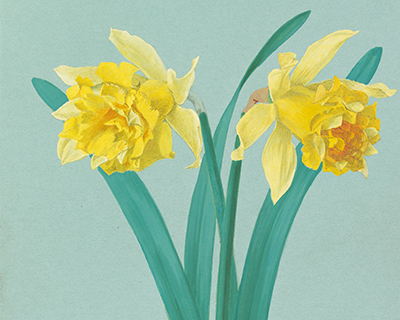Narcissus ‘Telamonius Plenus’ – the resilient daffodil
James Armitage travels back four centuries to tell the tale of apothecary John Parkinson, and one extremely durable daffodil.
The key to this dauntless bulb’s disappearing act in reverse is its hard-as-nails, never-say-die resilience. Be it in orchards, hedgerows, churchyards or old gardens, it shows an amazing will to persist, its merry yellow flowers bursting forth long after the souls who planted it have shuffled off their mortal coils. And there’s certainly been ample time for this penchant for perseverance to assert itself.
Born in 1567, Parkinson moved to London from Yorkshire when he was 14 years old to begin his training as an apothecary (something like a pharmacist today). He rose quickly in his profession and became apothecary to King James I and then Royal Botanist to King Charles I. A founder member of the Worshipful Society of Apothecaries, he was responsible for a botanical garden at Long Acre, near Covent Garden.
Daffodils, clearly, were of major interest to both Parkinson and his 17th-century readers. He devotes 41 pages to them, described under a chaotic array of archaic nomenclature. Among these entries can be found, bearing the tongue-twisting name Pseudonarcissus aureus Anglicus maximus, or Mr Wilmer’s Great Double Daffodil, a plant that we could still recognise today as Narcissus ‘Telamonius Plenus’.
When at last in that year it did flower, Sion had never seen the like and showed it to John de Franqueville, a London merchant and noted gardener, thinking that it was from him that he may have received the plant in the first place. John de Franqueville reported it was not known to him either and, thus encouraged of its novelty, Sion shared his daffodil with others, including Parkinson.
Needless to say, once established, its tough-as-old-boots nature means that it’s likely to be a faithful garden companion for many years to come.
However, his last years were not easy. He was a Catholic at a time when Catholicism was blamed for many ills of the land, and as a servant to royalty was viewed with further suspicion. King Charles I was executed in January 1649 and Parkinson died of old age in August the following year, aged 83. By the time of his death he was impoverished, his treasured library dispersed and the garden at Long Acre abandoned.
So the next time you cut back an old shrub and find yourself confronted with a bulb you can’t account for, go easy with the weeding fork. You could be in the presence of a piece of horticultural history.


